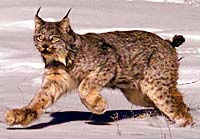Lynx Ruling Likely to Affect Skiers and Ski Areas

Vail, CO, Mar. 29-Last week, after years of debate and study, the U.S. Fish and Wildlife Service added the Canada lynx to its list of “threatened” species.
This new official designation means that both wildlife officials and developers alike will have to give new scrutiny to development plans in and around National Forest lands that serve as Lynx habitat.
While details of the formal lynx conservation plan have yet to be made public, the listing will mean increased scrutiny for any project on federal land that may affect lynx habitat, especially in the Rocky Mountain region where numerous ski areas currently exist.
The long-term affects may impact future ski area expansion, increased snowmaking, grooming, and other on-mountain activities.
“We really don’t know what the changes will be,” said Paul Witt, spokesman for Vail Resorts, owners of Vail, Beaver Creek Keystone and Breckenridge, all of which are located in moderate-to-prime lynx habitat. “Obviously there are going to be some impacts because many ski areas operate in areas that have been designated as lynx habitat, and with the new listing, there are some new rules and regulation that we’re all going to have to take a look at.”
According to the U.S. Forest Service, that may even mean going back and taking another look at projects that have already been approved. However, Witt added that all Vail Resorts expansion plans have had the lynx in mind from day one.
“We anticipated this ruling for a long time,” said Witt. “We may have to reexamine the work that we’ve done, but I don’t necessarily think we’ll have to do any new work.”
However, new projects may include more governmental red tape because the Endangered Species Act requires that all federal projects go through the U.S. Fish and Wildlife Service. The Forest Service and the USFWS have been informally communicating on several current projects, including increased snowmaking at Vail and Copper Mountain and terrain expansions at Keystone and Breckenridge. Now the Fish and Wildlife Service will also review those projects.
In addition, any future increase in on-mountain use, such as night skiing, additional cross-country trails, and night tubing activities may also come under new restrictions.
However, it is expected to take some time for studies to be completed in those areas to see just what impacts those activities impose on the lynx. “Is this going to affect us? And if so how?” Witt asked. “We just don’t know yet.”